 中
中
 400-9667-009
400-9667-009
 中
中
 400-9667-009
400-9667-009
Copper is the third most widely used metal in the world after iron and aluminum. It is widely used in aerospace, high-speed trains, smart terminal products, electronic communications, electric vehicles and other high-end industrial fields. The 1 μm band infrared fiber laser currently used on a large scale has the disadvantages of large spatter and uncontrollable melting depth in the processing of copper materials due to its weak absorption of copper. Spatter has a great negative impact on various application fields of copper materials. For example, in the processing of power batteries for new energy vehicles, spatter will not only affect the welding efficiency of copper materials, but also affect the production safety, performance and life of batteries.
At room temperature, the absorption rate of copper to near-infrared wavelengths (about 1 μm) is less than 5%, which is equivalent to 95% of the laser being reflected. The absorption rate of copper to green light wavelengths (532 nm) exceeds 40%, which is nearly an order of magnitude higher than the near-infrared band. Therefore, in order to better meet the needs of various fields for precision processing of high-reflectivity materials such as copper, the research on high-power green lasers is an extremely important topic. In addition, high-power green lasers can be used in the semiconductor field for semiconductor wafer annealing, low-temperature polycrystalline silicon (LTPS) display annealing, and solar cell manufacturing [1-2]; they can also be used in the entertainment industry for laser shows and laser projectors [3].
In recent years, commercial green lasers have made great progress. Germany's TRUMPF and the United States' IPG have achieved ultra-high power green light outputs of more than 3 kW and 1 kW respectively through disk laser technology and fiber laser technology. The output power of disk green lasers is higher, and the beam quality of fiber green lasers is better.
Fiber lasers have the characteristics of compact structure, high efficiency, easy heat dissipation, and flexible operation. They can output lasers with good beam quality, extremely high brightness, and extremely high energy density [4]. With the emergence of double-clad large mode field fibers, the improvement of semiconductor pumping performance, and the rapid development of fiber integration technology, the output power of fiber lasers has been rapidly improved [5]. There are dozens of units engaged in the research and development of fiber lasers in China, with an annual output value of tens of billions of yuan. At present, the output of single beam narrow linewidth has reached several kilowatts, and the beam synthesis scheme is expected to further increase the power of fiber lasers [6-7]. It is natural for the development of fiber lasers to be combined with the demand for green light sources. With the rapid development of high-power fiber lasers, the research on high-power green light sources based on fiber laser frequency doubling technology has also made certain progress and breakthroughs.
This paper conducts a detailed investigation on the development of high-power green light sources based on fiber laser frequency doubling technology. According to the different fundamental frequency light sources used, it is divided into two categories: single-beam fiber laser frequency doubling green light sources and multi-beam fiber laser frequency doubling green light sources. The fundamental frequency light sources, frequency doubling schemes, performance characteristics, etc. are investigated respectively. On this basis, two technical routes for the development of high-power fiber laser frequency doubling green light sources are summarized. Finally, the weak absorption of frequency doubling crystals limits the efficiency and power improvement of green light sources.
1. Frequency-doubled green light source based on single-beam fiber laser
In recent years, with the rapid development of high-power narrow-linewidth fiber lasers, research on single-beam fiber laser frequency-doubled green light sources has also made a lot of progress, and the output green light power has been rapidly improved.
In 2014, Gapontsev et al. from IPG of the United States reported a single-mode green laser based on a linearly polarized narrow-linewidth ytterbium-doped fiber laser in an LBO crystal with a single-pass frequency doubling scheme at the SPIE conference. The single-mode green laser can operate in both continuous (CW) and quasi-continuous (QCW) modes [8]. Figure 1 (a) and (b) are device diagrams of the CW and QCW schemes, respectively. The 1064 nm fundamental frequency light output by the narrow-linewidth single-mode fiber laser is focused onto the non-critical phase-matched crystal LBO, and a 532 nm green light is obtained after single-pass frequency doubling. The fundamental frequency light is then filtered out by a color separation mirror. In CW mode, the narrow linewidth fiber laser can output a maximum fundamental frequency of 1035 W. At this time, the output power is 356 W of continuous green light, the frequency doubling efficiency is close to 35%, the wall plug efficiency of the narrow linewidth laser is about 32%, and the wall plug efficiency of the entire green laser is about 11%, and the single-mode beam quality can be maintained at all powers. In QCW mode, because the peak power is higher and the frequency doubling efficiency is higher, the narrow linewidth fiber laser outputs an average power of up to 1067 W and a peak power of 2 kW. At this time, the output green light power exceeds 550 W, the frequency doubling efficiency is about 52%, the wall plug efficiency of the entire green laser is about 16%, and the beam quality is good.
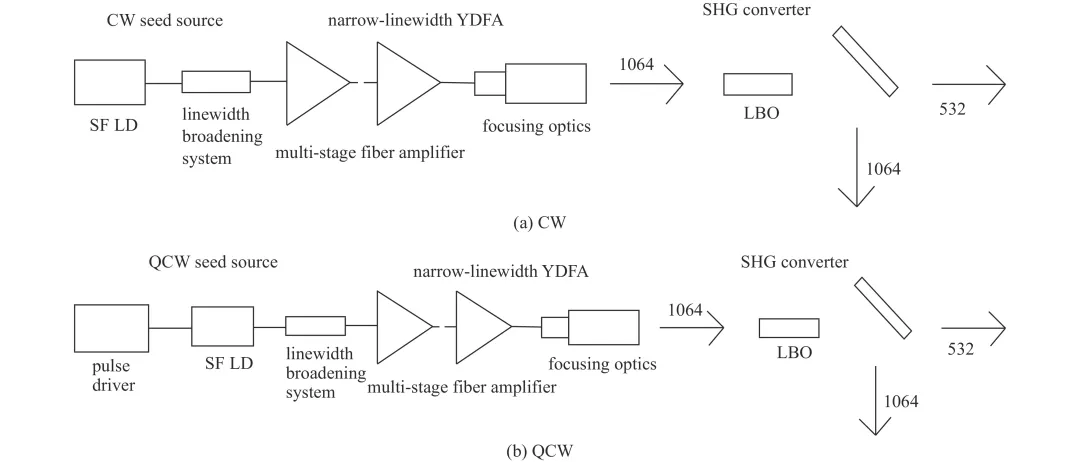
Figure 1. Optical path diagram of green light source based on linearly polarized narrow-linewidth fiber laser from IPG, USA
In 2015, the American IPG company further reported a quasi-continuous mode single-mode green laser based on a kW-class narrow linewidth linearly polarized single-mode ytterbium-doped fiber laser at the SPIE conference [9]. QCW fiber lasers operate within a duty cycle range of 2% to 100% and at repetition rates of tens to hundreds of MHz. Because the SBS threshold of QCW fiber laser is higher than that of CW fiber laser, the peak power is higher and the frequency doubling conversion efficiency is significantly improved. In QCW mode, the maximum average power obtained by the fundamental frequency light source is 993 W, and the peak power can reach 4.73 kW. At this time, the output green light power reaches 700 W, and the frequency doubling efficiency exceeds 70%. The wall plug efficiency of the entire green light laser system is About 23%, with a repetition rate of 150 MHz and single-mode beam quality maintained at all power levels.
In 2020, IPG of the United States launched the new VLM-532 and VLR-532 high-power green fiber lasers, which operate in pulse/quasi-continuous mode, with a repetition rate of up to 250 MHz, a pulse width of about 1.2 ns, a beam quality M2 <1.2, an electro-optical efficiency of 25%, and an output power of up to 1000 W. This is the world's first commercial kilowatt green single-mode fiber laser product with excellent performance and outstanding electro-optical conversion efficiency.
In 2020, Ahmadi et al. from Coherent reported at the SPIE conference a green laser based on a non-polarization-maintaining fiber laser combined with active polarization control technology. The laser used a single-pass frequency doubling scheme [10], and the device is shown in Figure 2. A 2 kW non-polarization-maintaining narrow-linewidth fiber laser was developed as the fundamental frequency light source. The fiber amplifier has multiple gain stages, and the linewidth of the seed source is broadened to 45 GHz or higher to increase the SBS threshold. After broadening, the seed laser passes through a polarization controller, which can change the polarization state of the laser at the input end to compensate for the polarization change in the fiber amplifier, so that the polarization state of the laser output by the fiber amplifier is fixed, achieving a polarization extinction ratio greater than 15 dB. The output of the fundamental frequency light source is collimated, and the beam sampler samples a small portion of the beam for polarization state analysis. Half of the power of the sampled beam is focused onto a photodetector through a half-wave plate and a polarization beam splitter to provide feedback signals to the polarization controller; the other half of the power is passed through another half-wave plate and a polarization beam splitter to measure the polarization extinction ratio of the laser. After the beam sampler, the high-power beam passes through a quarter-wave plate and a half-wave plate to finely correct the output polarization of the fiber amplifier to improve the SHG efficiency. The beam is then focused by a focusing lens onto a 55 mm thick LBO crystal with ultra-low loss developed by them. The crystal temperature is controlled at 150 °C to ensure non-critical phase matching, thereby maximizing the SHG efficiency. The green light output after filtering by the color separation mirror is collimated and coupled into a high-hydroxyl transmission fiber with a core diameter of 50 or 100 μm to suppress the photon darkening effect during high-power green light transmission. The photon darkening effect induces an increase in transmission loss, which will cause the slope efficiency and output power of the fiber laser to gradually decrease, accompanied by an increase in thermal dissipation. Suppressing the photon darkening effect can improve the power stability of the laser. The laser they designed ultimately achieved 1 kW green light output, a frequency doubling efficiency of 54%, and a beam quality M2 of 1.01.
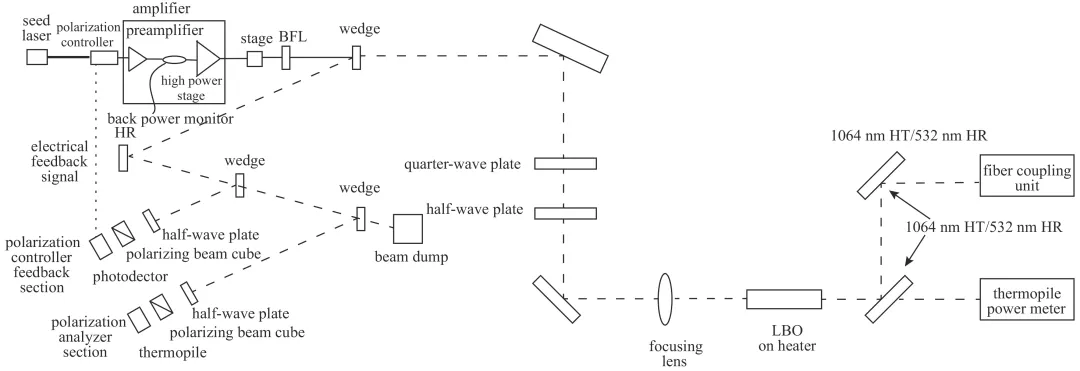
Figure 2. Optical path diagram of green light source based on non-polarization-maintaining fiber laser combined with active polarization control technology from Coherent
In China, the Shanghai Institute of Optics and Precision Mechanics of the Chinese Academy of Sciences has conducted a series of research in the field of high-power fiber green lasers. In April 2021, Su Mengqi et al. from the Shanghai Institute of Optics and Precision Mechanics of the Chinese Academy of Sciences reported a high-power continuous-wave green laser based on a single-pass frequency doubling scheme of a narrow-linewidth polarization-maintaining fiber laser [11]. The device diagram is shown in Figure 3. The fundamental frequency light source is a kW-class narrow-linewidth polarization-maintaining all-fiber laser independently developed by the research group. The linewidth is about 20 GHz, the polarization extinction ratio (PER) is higher than 15 dB, and the beam quality M2 is better than 1.1. A type I non-critical phase-matched LBO crystal is used as the frequency doubling crystal, and based on the Semmier equation, the factors affecting the non-critical phase matching of the LBO crystal are theoretically analyzed, the acceptance linewidth and matching temperature of the LBO crystal for the fundamental frequency light are calculated, and the frequency doubling structure is optimized based on the results, and the focal length of the focusing lens and the crystal control temperature are designed. The laser can achieve a maximum continuous green light output of 321 W at a fundamental frequency of 784 W, with a frequency doubling efficiency of 40.9% and a beam quality M2 of 1.07.

Figure 3. Optical path of the green light source based on narrow linewidth polarization-maintaining laser of Shanghai Institute of Optics and Fine Mechanics
In July of the same year, the research group reported a 610 W single-mode continuous green light output based on this scheme. At this time, the fundamental frequency light power was 1084 W, the frequency doubling efficiency reached 56.27%, the beam quality M2 was 1.05, and the output far-field spot had a fundamental transverse mode morphology [12]. The schematic diagram of the device they used is shown in Figure 4. The light beam output by the fundamental frequency light source is collimated by a collimator, and then focused into the LBO crystal through a half-wave plate (HWP) and a lens in sequence. The polarization direction of the fundamental frequency light entering the LBO crystal is changed by adjusting the half-wave plate, and the focal length of the focusing lens is optimized to obtain the highest frequency doubling efficiency. After filtering out the fundamental frequency light with a dichroic mirror, green light output is obtained.
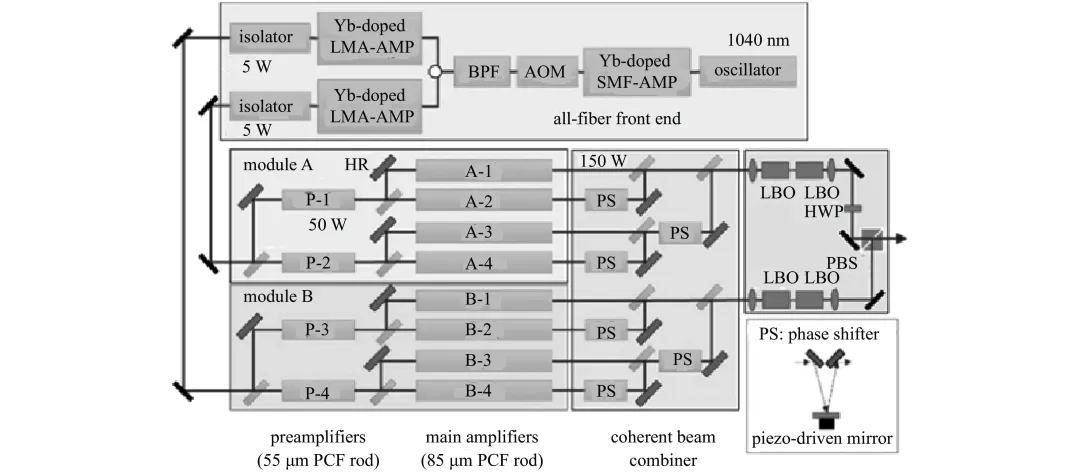
Figure 4. System optical path diagram of Osaka University's green and ultraviolet light generation system based on high-power nanosecond pulsed fiber lasers
In terms of domestic commercial green light fiber laser products, in October 2021, Raycus Laser launched two ns green light lasers. Both lasers use fiber frequency doubling solutions, with maximum average powers of 50 W and 200 W respectively, repetition frequencies of 2 MHz and 25 MHz respectively, and narrow pulse widths designed to be 1.5 to 10 ns. The pulse waveform is modulatable, the pulse stability (peak-to-peak value) is <2%, and the beam quality M2 is <1.2.
June 2022,Shenzhen Gongda Laser has launched the single-mode green laser GCL-500, which can be used for high-reflection metal 3D printing and precision welding. The laser adopts an all-fiber baseband plus single-pass frequency doubling solution, and can achieve a single-mode continuous green light output of up to 500 W.
2. Frequency-doubled green light source based on multi-beam fiber laser
There are two main schemes for obtaining high-power fiber green light sources based on frequency doubling of multi-beam fiber lasers: one is to realize the frequency doubling process and the beam combining process independently, obtain high-power fundamental frequency light through beam combining, and then double the frequency to obtain green light output, or obtain high-power green light output through polarization beam combining; the other is to use quasi-non-collinear critical phase matching of nonlinear crystals, and realize the beam combining process and frequency doubling process simultaneously through a single crystal.
In 2017, Koji Tsubakimoto et al. of the Laser Engineering Institute of Osaka University reported a system for obtaining green light and ultraviolet light based on high-power ns-level pulsed fiber lasers [13]. Figure 4 is a schematic diagram of the device they used. The beam output from the seed source is amplified by an ytterbium-doped single-mode fiber amplifier and then divided into two beams by a fiber beam splitter, and then amplified by an ytterbium-doped large mode area fiber amplifier and a PCF amplifier. Module A and module B each have four laser beams, and the four beams of each module are combined into a single beam output. This process is equivalent to obtaining two high-power fundamental frequency light sources by beam combining. The frequency doubling module is composed of type I LBO crystal (for frequency doubling) and type II LBO crystal (for frequency tripling). When performing the frequency doubling experiment, the type II LBO crystal is removed, and the two fundamental frequency lights output by module A and module B are frequency doubling by type I LBO crystal and then polarization beam combined by PBS; when performing the frequency tripling experiment, the fundamental frequency light is focused in the middle of type I LBO crystal and type II LBO crystal, and the two ultraviolet light beams are then polarization beam combined by PBS.
In the experiment, the four-beam synthesis efficiency of the two modules is 83% and 90% respectively, and the polarization beam combining efficiency of PBS for green light and ultraviolet light is ≥98%. The maximum average power of the fundamental frequency light is 955 W, the pulse width is 285 ps, the peak power intensity is about 2 GW/cm2, the repetition frequency is 10 MHz, the maximum average power of the output green light is 600 W, the frequency doubling efficiency is about 67%, the maximum power of the output ultraviolet light is 300 W, the conversion efficiency is about 40%, and the beam quality M2 can be maintained at 1.3 at high power.
The second solution to achieve frequency doubling of multi-beam fiber lasers was proposed by Michailovas et al. of EKSPLA, Lithuania, in a European patent in 2010 [14]. When beam synthesis and frequency conversion are two independent processes, if you want to generate high-energy and high-frequency pulses, you need two devices, one for beam synthesis and the other for nonlinear optical frequency conversion. However, this system is inefficient and not practical enough. In addition, using two independent devices also makes it difficult to control the phase of the laser beam. The beam synthesis method proposed in this patent can combine multiple laser beams into a single laser beam with higher energy, and simultaneously achieve the two processes of frequency doubling and beam combining. The specific device of the patent is shown in Figure 5. The initial light beam output by the fiber laser (11, 12, ..., 1n) is focused onto a type II nonlinear crystal 3 (such as KTP, LBO, DKDP, etc.) through a collimator (21, 22, ..., 2n). These output laser beams 4 are not collinear with each other, and their sum frequency beams 5 are synthesized and output as a light beam 6; the remaining part of the initial light beam (71, 72, ..., 7n) is absorbed by an absorption module (81, 82, ..., 8n).
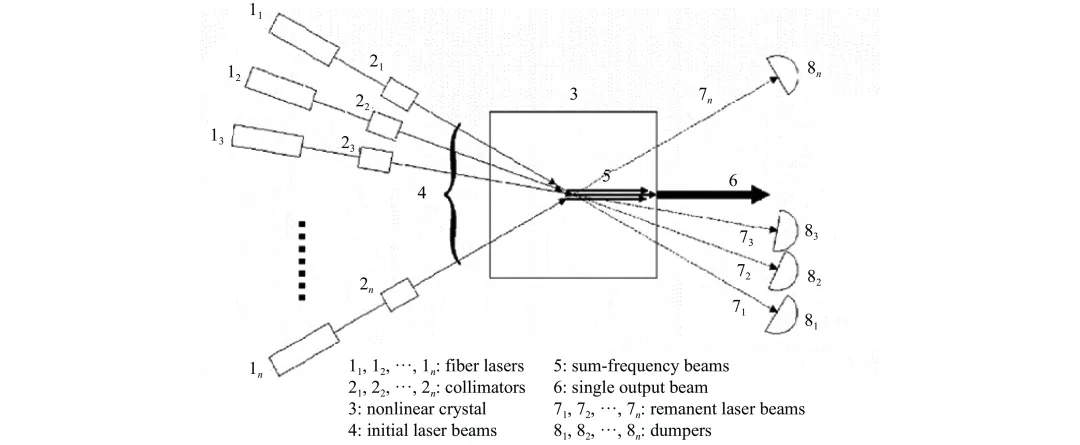
Figure 5: The frequency doubling and beam combining solution proposed by Lithuanian company EKSPLA in its European patent
In 2017, JULIJANAS et al. from the Lithuanian Center for Physical Sciences and Technology reported a multi-beam fiber laser frequency doubling experiment based on the beam synthesis method proposed by Michailovas et al. in a European patent, and conducted a four-way beam combination concept verification experiment [15]. The experimental setup is shown in Figure 6. They selected 4 beams (2 pairs) of fundamental frequency beams. All fundamental frequency lasers were pulsed lasers with a pulse width of 200 ps, a pulse energy of 31 μJ, a maximum average output power of 16 W, and a beam waist diameter of 200 μm. The sum frequency beams generated by different fundamental frequency beam pairs overlapped in space to obtain a single beam. The experiment adopted an incoherent scheme. In order to avoid the inverse conversion process affecting the frequency doubling efficiency, it was necessary to control the initial moment of the laser to make the group synchronous and the group asynchronous. The experiment obtained a maximum conversion efficiency of 51% at a fundamental frequency optical power of 4×10 W, and a maximum average power of 29 W of green light output at 4×16 W, with a conversion efficiency of about 49%. At the highest conversion efficiency, the beam quality M2 of the output green light was 1.32 and 1.16 in the horizontal and vertical directions, respectively. Through this experiment, they proved the feasibility of obtaining green light by frequency doubling and combining. Based on the minimum angular spacing that the beams can reach, they estimated that the total number of beams can reach 14, and increasing the non-collinear angle may also combine more beams. The increase in average power of this scheme is mainly limited by the peak power of the fundamental frequency fiber laser and the thermal effect in the nonlinear crystal.
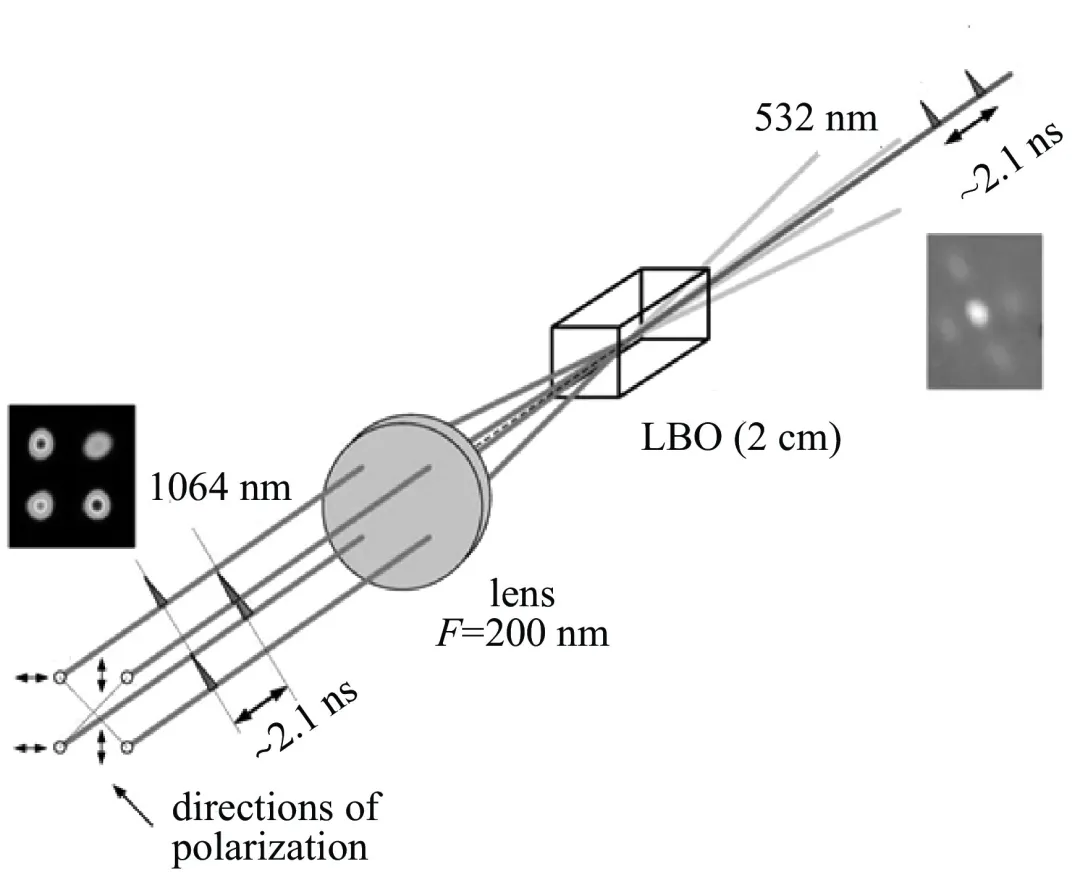
Figure 6 Optical path diagram of the four-way beam combining experiment based on the frequency doubling beam combining incoherent scheme at the Lithuanian Center for Physical Science and Technology
In 2019, Julijanas et al. further reported a 97 W green light output based on a four-way sub-beam frequency doubling and combining scheme, proving the feasibility of the frequency doubling and combining coherent scheme [16]. The experimental setup is shown in Figure 7. The fundamental frequency pulse width is 240 ps, the pulse energy is 66.7 μJ, the maximum average output power is 60 W, and the beam waist diameter is 230 μm. Two pairs of sub-beams are used for synthesis, and the phase of one of the four laser beams is controlled to achieve the control of the frequency doubling laser phase. When the phases of different groups of frequency doubling lasers are the same, coherence enhancement is achieved. The maximum conversion efficiency of 49% was achieved when the fundamental frequency light power was 4×26 W. Further increase in output power will lead to a decrease in conversion efficiency, which may be caused by poor beam quality of the fundamental frequency beam and the reverse conversion effect. At a fundamental frequency light power of 4×60 W, the conversion efficiency dropped to 40%, and the sum frequency beam reached an average power of 97 W. At low conversion efficiency, M2 < 1.1, but the beam quality deteriorated with the increase in efficiency. They attributed this to the beam quality problem of the fundamental frequency light.
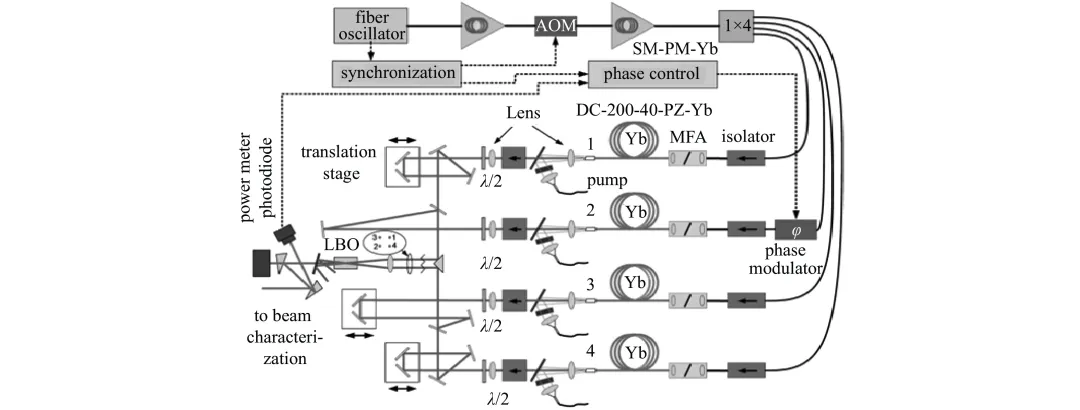
Figure 7. Four-way beam combining experimental device based on the frequency doubling beam combining coherent scheme at the Lithuanian Center for Physical Science and Technology.
3. Discussion and Analysis
At present, there are two technical routes for the research of green light sources based on high-power fiber laser frequency doubling: single beam and multi-beam. Regardless of which route, the research on fundamental frequency light sources is extremely important. In order to make the fundamental frequency light easier to convert into the second harmonic and thus obtain higher conversion efficiency, the fundamental frequency light source needs to meet the performance requirements of high peak power, narrow linewidth, and linear polarization. The narrower the bandwidth, the higher the conversion efficiency. For LBO crystals, the bandwidth should generally not exceed 30 GHz. The higher the polarization purity of the fundamental frequency light source, the better. Generally, the polarization extinction ratio PER is required to be higher than 15 dB. Polarization-maintaining fiber lasers or polarization control schemes can be used. In addition, the frequency doubling conversion efficiency is proportional to the peak power density. Therefore, the peak power density can be increased by using quasi-continuous fiber lasers and frequency doubling at the focal position after focusing.
Frequency doubling scheme is another design focus of high-power green fiber light sources. According to the survey results, LBO has been selected as the frequency doubling crystal in the research of various schemes at home and abroad. LBO crystal is an excellent nonlinear crystal, belonging to the orthorhombic crystal system, with birefringence characteristics and strong anti-deliquescent properties. It has a wide spectral transmission range (transmittance range 210-2300 nm), a high nonlinear coefficient, a high laser damage threshold and ideal chemical and mechanical properties. LBO crystals are often used in a series of nonlinear laser conversions such as frequency doubling and frequency tripling. Its nonlinear coefficient is about 3 times that of KDP [17]. LBO crystals can be used to achieve both critical phase matching and noncritical phase matching (type I frequency doubling noncritical phase matching in the 1000-1300 nm band and type II frequency doubling noncritical phase matching in the 800-1100 nm band), so they are used in a variety of technical routes.
Using LBO crystals, there are currently two commonly used designs for frequency doubling of high-power green fiber light sources: type I noncritical phase matching and type II non-collinear critical phase matching. In type I phase matching, two relatively nonlinear crystals have ordinary light polarization (o light) photons combined to produce a frequency doubling photon with extraordinary light polarization (e light). In type II phase matching, a photon of ordinary light polarization (o light) and a photon of extraordinary light polarization (e light) combine to produce a doubled frequency photon of ordinary light polarization. Non-critical phase matching mainly uses the property that the ne of anisotropic birefringent crystals changes with temperature, and adjusts the crystal temperature to achieve the matching of the refractive index of the fundamental light and the doubled frequency light in the crystal; while critical phase matching is achieved by adjusting the angle of the incident light, also known as angle phase matching. Two fundamental frequency photons interact and annihilate to produce a doubled frequency photon. If the three propagate in the same direction and the light overlaps, it is called collinear phase matching; if the two fundamental frequency light beams participating in the sum frequency are not collinear, the doubled frequency light and the two fundamental frequency light beams are not collinear, which is called non-collinear phase matching. The advantage of non-collinear phase matching is that the propagation directions of the fundamental frequency light and the doubled frequency light are different, and it is easy to separate the doubled frequency light and the remaining fundamental frequency light after emitting from the crystal, but the non-collinear angle difference is too large, which will increase the walk-off and reduce the doubled frequency efficiency.
The advantages of type I noncritical phase matching are high conversion efficiency due to high nonlinear coefficients, and the process is insensitive to angles. The power density inside the crystal can be increased by focusing the frequency doubling. In addition, there is no spatial walk-off in the process, and the beam quality is good. The disadvantage of this scheme is that the crystal requires a high temperature environment of 150 °C, and temperature control and high threshold of the components are difficult. Most single-beam fiber laser frequency doubling adopts type I noncritical phase matching, and the scheme for obtaining high-power green light is usually single-pass frequency doubling, that is, the fundamental frequency light is directly generated after being incident on the frequency doubling crystal, and the fundamental frequency light only passes through the frequency doubling crystal once. Compared with the resonance enhancement scheme [18], the single-pass frequency doubling structure is simple, does not require a complex frequency stabilization system, and the laser passes through once, which has good robustness. Taking a 1064 nm continuous laser with a beam waist radius of 0.1 mm as an example, Figure 8 is a theoretically calculated curve of the relationship between the fundamental frequency optical power and the output green light power when the crystal thickness is 40 mm and 60 mm. When the fundamental frequency optical power is 2000 W, the 60 mm crystal outputs a green light power of 1170 W, with an efficiency of about 58.5%; the 40 mm crystal outputs a green light power of 1020 W, with an efficiency of about 51%.
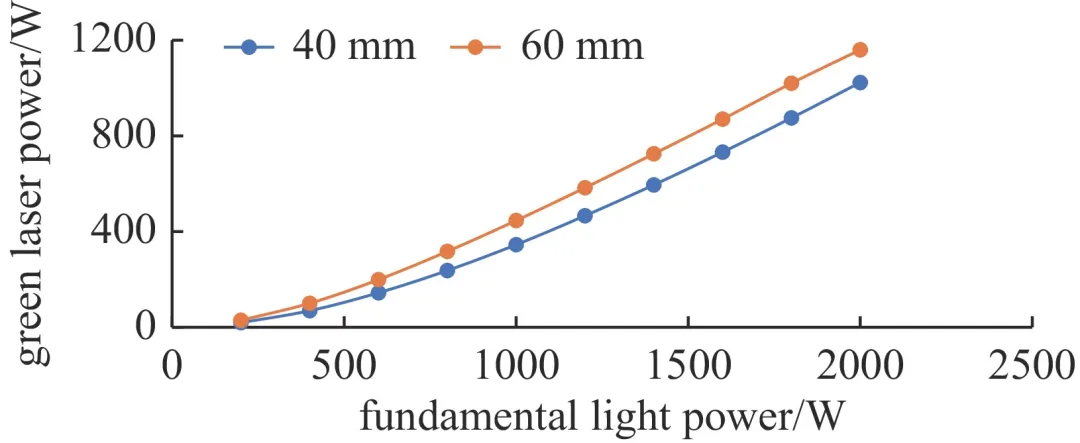
Figure 8 Relationship between output green light power and fundamental frequency light power when the crystal thickness is 40 mm/60 mm
The frequency doubling scheme based on type II non-collinear critical phase matching can realize beam combining and frequency doubling processes simultaneously. For LBO crystals, the Fresnel wave normal equation is used to calculate the phase matching angle. The matching direction of the fundamental frequency beam corresponds to the direction of the sum frequency beam, and two phase matching circles are obtained. Figure 9 (a) is the phase matching circle of type II LBO crystal (the horizontal and vertical cutting angles are θ=21°, φ=90°, and the thickness is 20 mm). Any pair of fundamental frequency lights symmetrical about the center on the phase matching circle can generate sum frequency light at the center of the matching circle. The advantages of this scheme are that it works at room temperature, temperature control and high threshold of components are simple, and multiple pairs of sub-beams can be arranged. The sub-beams have coherent and incoherent options for non-collinear injection, which is conducive to higher power or ultra-narrow linewidth high power output, and can also automatically achieve color separation of the remaining unconverted laser. Taking type II LBO crystal (cutting angle θ = 21°, φ = 90°, thickness 20 mm) as an example, the laser divergence half angle is 3.25 mrad, and 18 sub-beams can be arranged in 5 rows on the phase matching circle, as shown in Figure 9 (b). The number of sub-beams that can be arranged can be increased by changing the crystal cutting angle to increase the radius of the two matching circles, or by increasing the focal length of the focusing lens and reducing the divergence angle. When the energy of the fundamental frequency light source is high enough, this scheme is expected to obtain ultra-high power green light output.
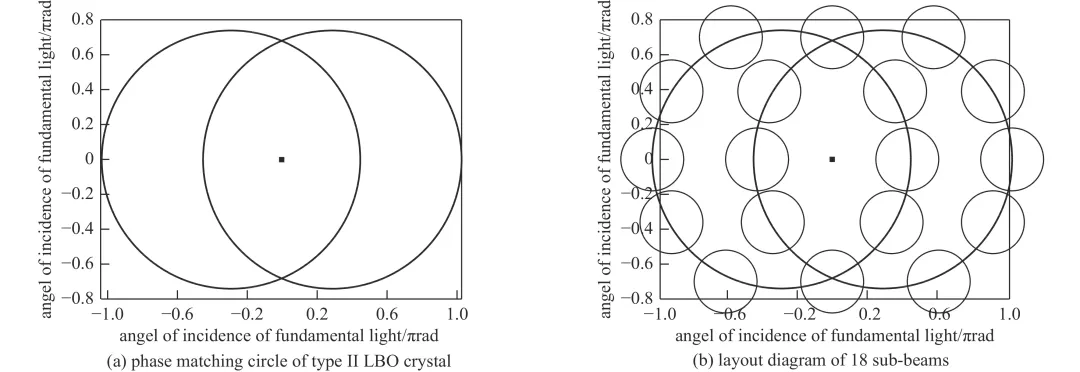
Figure 9. Schematic diagram of the phase matching circle of type II LBO crystal and the arrangement of 18 sub-beams on the matching circle.
Regardless of the frequency doubling scheme chosen, the weak absorption of LBO crystals is a common factor that limits the frequency doubling efficiency and output power improvement. Under high average power laser irradiation, due to the photothermal properties of the crystal itself, such as thermal diffusivity, thermal conductivity, and photothermal coefficient, a local photothermal effect (thermal lens effect) will be caused at the laser irradiation position [19], resulting in weak absorption of light energy by the crystal. Studies have shown that weak absorption values can usually directly reflect the absorption capacity of the crystal material for a certain wavelength beam. This property will directly affect the application of the crystal in frequency doubling. The higher the weak absorption value, the more heat the crystal absorbs, and the higher the crystal temperature. On the one hand, this affects phase matching and leads to a decrease in conversion efficiency, and on the other hand, it may cause crystal damage.
The crystal used for frequency doubling must have high conversion efficiency and long life expectancy. This is particularly challenging when applied to high-power lasers. Minimizing the surface absorption and volume absorption of the crystal is the key to meeting these requirements.
The surface absorption of the crystal is directly related to the roughness of the crystal surface. Any unevenness on the surface will lead to increased surface absorption of the crystal. When applied to high-power lasers, the surface roughness of the crystal is generally required to reach the order of 10−10 m. In addition, excessive absorption of optical films on the crystal surface can cause damage to the film. Therefore, it is necessary to measure the absorption of the film and optimize the film based on the measurement results: select appropriate coating materials; improve coating process parameters (such as temperature, ion source intensity, etc.); improve the quality of the polished substrate (the film layer absorption is too large, it may also be that the substrate polishing parameters are not suitable or the wiping solution is not suitable). Common path interferometry (PCI) is usually used to measure the surface absorption of crystals [20]. PCI can measure the absorption loss on the crystal surface and in the film with high sensitivity and accuracy.
The volume absorption of crystals is generally caused by impurities, color centers, conduction band electrons, or areas that are easily heated, melted, and cracked by laser irradiation. Due to the influence of electronic and molecular absorption, these are particularly obvious in the ultraviolet and infrared spectral regions [21]. If the crystal purity is not high enough or the structure is irregular, the volume absorption will increase. In order to minimize the volume absorption, the crystal itself must have a very high quality. When applied to high-power lasers, the crystal is generally required to have a low volume absorption of the ppm level. The measurement of low volume absorption is difficult, but laser induced deflection (LID) technology can be used to achieve accurate measurement [22].
4. Conclusion
Copper materials have important applications in aerospace, high-speed trains, smart terminal products, electronic communications, electric vehicles and other industries. Green light has an absorption efficiency nearly one order of magnitude higher than the 1 μm laser commonly used in the market. It can better meet the needs of various fields for precision processing of high-reflective materials such as copper. Therefore, high-power green lasers have very broad application prospects.
In recent years, high-power green light sources based on fiber laser frequency doubling technology have developed rapidly. According to the type of fundamental frequency light source, the technical route is roughly divided into two: one is to use a high-power single-beam fiber laser as the fundamental frequency light source, and then cascade a single-pass non-critical phase-matched LBO crystal as the frequency doubling; the other is to use a multi-beam fiber laser as the fundamental frequency light source, and then realize synthesis and frequency doubling separately, or synthesis and frequency doubling in one. At present, the frequency-doubled green light source based on single-beam fiber lasers has reached a kilowatt output, and there are continuous research reports and product launches at home and abroad. Frequency doubling based on multi-beamlet fiber lasers can realize the frequency doubling process and the beam combining process independently, or the beam combining process and the frequency doubling process can be realized simultaneously through the quasi-non-collinear critical phase matching of nonlinear crystals. The latter currently only has a proof-of-concept experiment at low power.
Comparing the two technical routes, single-beam frequency doubling is relatively simple, while multi-beam frequency doubling has the potential for higher output power, but the weak absorption of the frequency doubling crystal is a common problem faced by both technical routes. Weak absorption will directly affect the application of crystals in frequency doubling. Minimizing the surface absorption and volume absorption of crystals is the key to manufacturing crystals with high conversion efficiency and long life expectancy. Surface absorption is directly related to the roughness of the crystal surface and is usually measured by CPI; volume absorption is affected by the purity and structure of the crystal and can be measured by LID technology. When applied to high-power laser frequency doubling, it is generally required that the surface roughness of the crystal reaches the sub-nm level and has a low volume absorption of the ppm level.
Source: "High Power Laser and Particle Beams" 2023 Vol. 35 No. 7